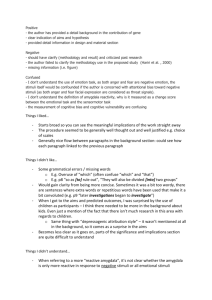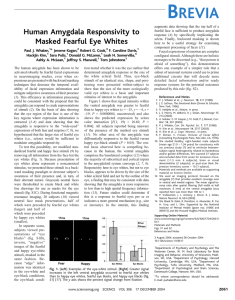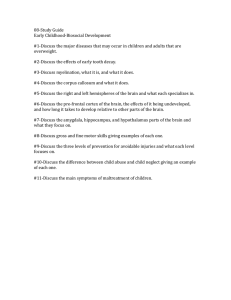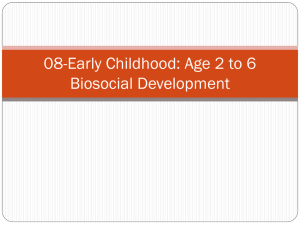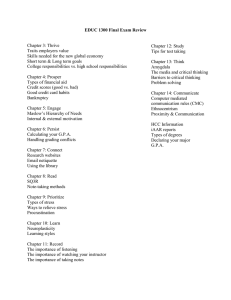Supporting Online Materials 1) Study Details. Eye stimuli (and
advertisement
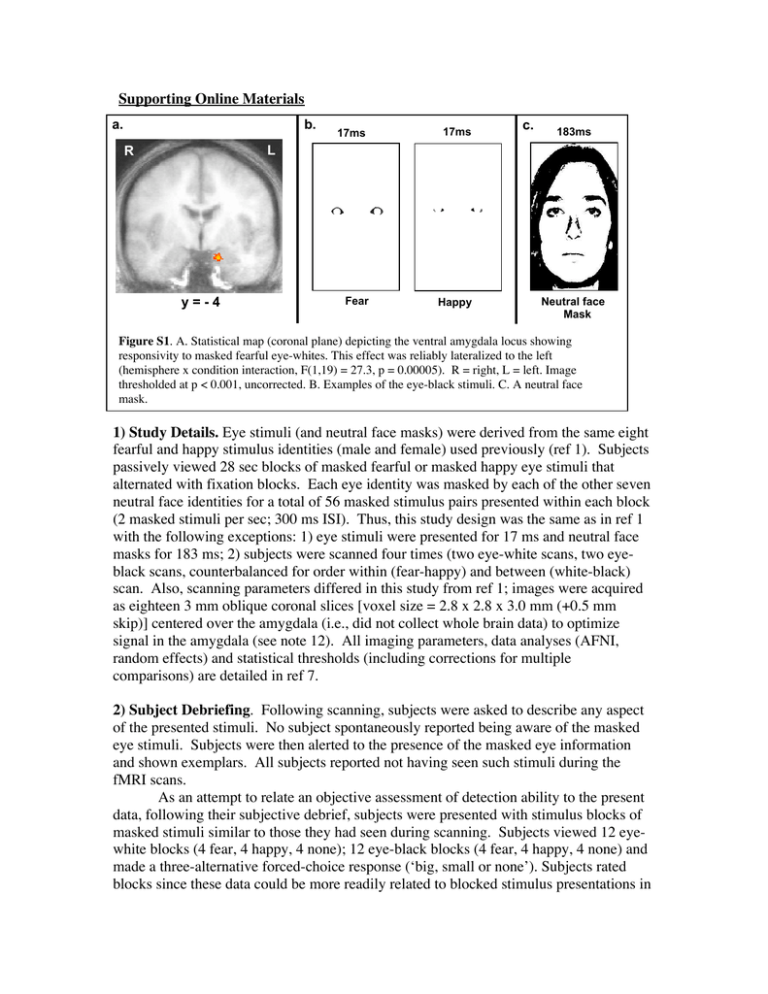
Supporting Online Materials a. b. 17ms 17ms Fear Happy c. 183ms L R y=-4 Neutral face Mask Figure S1. A. Statistical map (coronal plane) depicting the ventral amygdala locus showing responsivity to masked fearful eye-whites. This effect was reliably lateralized to the left (hemisphere x condition interaction, F(1,19) = 27.3, p = 0.00005). R = right, L = left. Image thresholded at p < 0.001, uncorrected. B. Examples of the eye-black stimuli. C. A neutral face mask. 1) Study Details. Eye stimuli (and neutral face masks) were derived from the same eight fearful and happy stimulus identities (male and female) used previously (ref 1). Subjects passively viewed 28 sec blocks of masked fearful or masked happy eye stimuli that alternated with fixation blocks. Each eye identity was masked by each of the other seven neutral face identities for a total of 56 masked stimulus pairs presented within each block (2 masked stimuli per sec; 300 ms ISI). Thus, this study design was the same as in ref 1 with the following exceptions: 1) eye stimuli were presented for 17 ms and neutral face masks for 183 ms; 2) subjects were scanned four times (two eye-white scans, two eyeblack scans, counterbalanced for order within (fear-happy) and between (white-black) scan. Also, scanning parameters differed in this study from ref 1; images were acquired as eighteen 3 mm oblique coronal slices [voxel size = 2.8 x 2.8 x 3.0 mm (+0.5 mm skip)] centered over the amygdala (i.e., did not collect whole brain data) to optimize signal in the amygdala (see note 12). All imaging parameters, data analyses (AFNI, random effects) and statistical thresholds (including corrections for multiple comparisons) are detailed in ref 7. 2) Subject Debriefing. Following scanning, subjects were asked to describe any aspect of the presented stimuli. No subject spontaneously reported being aware of the masked eye stimuli. Subjects were then alerted to the presence of the masked eye information and shown exemplars. All subjects reported not having seen such stimuli during the fMRI scans. As an attempt to relate an objective assessment of detection ability to the present data, following their subjective debrief, subjects were presented with stimulus blocks of masked stimuli similar to those they had seen during scanning. Subjects viewed 12 eyewhite blocks (4 fear, 4 happy, 4 none); 12 eye-black blocks (4 fear, 4 happy, 4 none) and made a three-alternative forced-choice response (‘big, small or none’). Subjects rated blocks since these data could be more readily related to blocked stimulus presentations in the scanner. Addition of the ‘none’ condition allows for the determination of the unique sensitivity to each fearful and happy stimulus category, since a two-alternative forcedchoice task allows for above chance performance in one category to produce above chance performance in the other by default, rather than via actual detection. Note that our objective measure assesses ability to discriminate fearful from happy eye stimuli, and does not address other objective choices (e.g., flicker/no flicker). Better than chance performance was determined by calculation of a detection sensitivity index (d’) based upon the percentage of trials a masked stimulus was detected when presented [‘hits’ (H)] adjusted for the percentage of trials a masked stimulus was ‘detected’ when not presented [‘false alarms’ (FA)]; [d’ = z-score (percentage H) – z-score (percentage FA), with chance performance = 0+1.74]. Each subject’s detection sensitivity was calculated separately for each of the stimulus categories and then averaged (cf. Maxwell & Davidson, 2004). We then rank ordered the 20 subjects based upon their detection performance. Subjects’ rank ordering was virtually identical and all results remained unchanged when detection sensitivity was calculated using A’, the nonparametric analogue of d’ (Haase, Theios & Jenison, 1999; Macmillan & Creelman, 1991). There was no difference in Fear (F) vs. Happy (H) % signal change (t (16) = .322, p =.75) when we divided subjects into Chance performers (N=7), group mean d’ = .22, FvH %sc = .33+.07 and Above Chance performers (N=11), group mean d’ = 4.04, FvH %sc = .29+.08. (We excluded two subjects from this analysis who had high negative d’ scores (> -1.74) which signify that they were inaccurate, but not responding randomly). As a more conservative comparison, we further divided the subjects into two groups of equal size (excluding intermediate performers): Clearly Chance performers (N=6), poorest detectors, FvH %sc = .37+.075 and Clearly Above Chance performers (N=6), best detectors, FvH %sc = .30+.084. Signal change did not differ between these two extreme groups (t (10) = .601, p = .56). With specific reference to Fig. 1, detection scores for the fearful eye white condition did not differ when compared with the happy eye-white condition (t (18) = .71, p =.49), the fearful eye-black condition (t (18) =-.61, p =.55) or the happy eye-black condition (t (18) =.86, p =.40). Together, these data show that differences in post-scan detection ability (measured across subjects at the group level, or within-subject at the stimulus condition level) did not explain ventral amygdala responsivity to fearful eye-whites observed during a prior passive-viewing task in subjects who were naïve to the presence of the masked stimuli. Such a strategy avoids the interactive effects of competing task demands that can influence BOLD signal changes in the amygdaloid region (Shulman et al., 1997; see also Bush, Luu & Posner 2000; Gusnard & Raichle, 2001; Hariri et al., 2000; Lange et al., 2003; Whalen et al., 1998). 3) Backward masking. Backward masking was used here to decrease subjective awareness of the abnormal experience of viewing eye-whites not grounded to a face. Indeed, overt presentations of these eye-white stimuli in a separate group of subjects revealed reports of their irregular nature that varied across subjects (e.g., “eyes floating”, “looked like cat-eyes”). Such ‘competing cognitions’ during overt stimulus presentations would likely confound attempts to assess component processing of faces. 2 a. Hippocampus Amygdala b. Figure S2. Two brain regions showing correlated activity with the amygdala locus responsive to fearful eye-whites. A. A region of the hippocampus (x= -28, y= -10, z= -17, p=.0024 uncorrected) constituting a separate cluster from the amygdala is positively correlated with amygdala responsivity to fearful eye-whites. Subjects with higher amygdala signal values showed higher hippocampal signal values. This statistical map was derived by using the signal values at the left amygdala locus pictured in Figure 1 as the predictor variable in a voxel-wise regression analysis. Amygdala is observed here because it is, of course, correlated with itself. We note that we also observed a significant temporal correlation at this hippocampal locus (i.e., activity was significantly correlated with amygdala across conditions on a within-subject basis, p = .0000053, uncorrected). Units on axes = z-scores. Image thresholded at p=.02 uncorrected. B. A region of the ventral medial prefrontal cortex (vmPFC): (x= -1, y= 27, z= -18, p = .0004, uncorrected) is negatively correlated with amygdala responsivity to fearful eye-whites. Subjects with higher amygdala signal intensities, showed lower vmPFC signal intensities. We did not observe a significant temporal correlation at this locus, perhaps related to the fact that ventral medial regions of the PFC (venromedial orbitofrontal cortex) do not demonstrate as strong a reciprocal connectivity with the amygdala, compared with immediately more lateral (ventrolateral orbitofrontal cortex) and superior (subgenual anterior cingulate) regions of the PFC (i.e., this could be an indirect effect; see e.g., Kringelbach & Rolls, 2004). Note: Three subjects who did not have adequate vmPFC signal quality were excluded from this analysis. Axes, Image parameters, and methods as in A. Note: We attempted to assess the fusiform gyrus but did not have adequate coverage. The fact that we observed no main effect at these regions, but they were nonetheless correlated with amygdala activation, speaks to the modulatory nature of these effects. These data could be interpreted as evidence of a modulatory input that is subthreshold for activation of these regions but would facilitate subsequent responding within these regions. In this scenario, following amygdala response to fearful eye-whites, hippocampus would have a lower response threshold and vmPFC would have a higher response threshold for response 3 to subsequently encountered stimuli. References Bush, G., Luu, P., & Posner, M. I., Trends Cogn Sci, 4, 215 (2000). Gusnard, D. A. & Raichle, M. E. Nat Rev Neurosci, 2, 685 (2001). Haase, S.J., Theios, J., & Jenison, R. Perception & Psychophysics, 61, 986 (1999). Hariri, A. R., Bookheimer, S. Y., & Mazziotta, J. C. Neuroreport, 11, 43 (2000). Kringelbach, M.M. & Rolls, E.T Prog in Neurobiol 72:341 (2004).. Lange, K., et al., Biol Psychiatry, 53, 226 (2003). Macmillan, N.A., & Creelman, C.D. Detection theory: A user’s guide. New York: Cambridge University Press (1991). Maxwell J.S. & Davidson, R.J., Cognition & Emotion, 18, 1009 (2004). Shulman, G.L. et al., J Cog Neurosci, 9, 648 (1997). Whalen, P.J., et al., Biol Psychiatry, 44, 1219 (1998). 4
